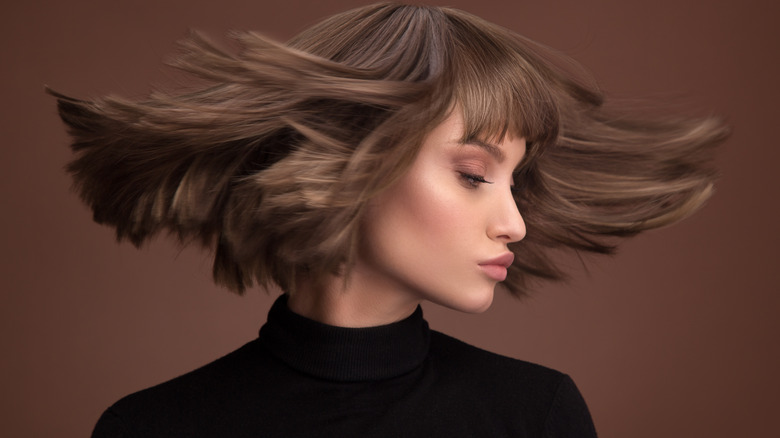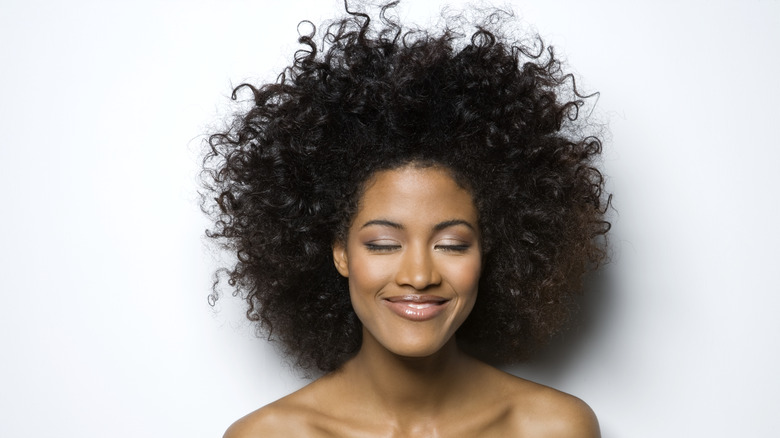The Key To Hair Health? Your Protein-Moisture Balance
Healthy hair hinges on the balance between protein and moisture. And while we might think that more is more when it comes to protein and moisture for hair, there's actually a fine line that needs to be maintained. When it comes to moisture in the hair, a lot depends on your hair's porosity levels. Porosity just means how well your hair holds onto moisture, and this varies between hair types. Hair porosity depends largely on genetics and can also change over time due to harsh processing treatments or excessive sun exposure.
There's actually a great way to check your hair porosity. Wash it and dry it, then drop a piece of dry hair into a glass of water. If the hair floats, you have low porosity. If it hovers in the middle of the glass, this means you have normal hair porosity. If it sinks to the bottom, that means you have high hair porosity. This is a useful piece of information to have going forward in figuring out how to manage the moisture balance in your hair. So here's everything to know about maintaining the harmony between moisture and protein.
How to keep moisture balance
It's crucial to properly balance moisture in your hair. Excessive moisture leads to something called hygral fatigue. This typically comes from excessive deep conditioning treatments. To test if your hair is in hygral fatigue, note how it feels. If the hair feels limp and dull, then it's likely in moisture overload. Also, look for split ends when hair is dry. This means the moisture-protein balance is off. The reason hair struggles with excessive moisture is because hair cuticles have to absorb and contract to receive moisture. When there's too much moisture, your hair cuticles become overworked, leaving hair with that telltale limpness that speaks to excessive hydration.
So what's to be done? "To rebalance overly moisturized hair, consider using a conditioner that has protein in it or using a protein treatment," hair expert Precious Rutlin told Byrdie. Rutlin said that doing this at least once a month is a good start, but be careful about being excessive with it. If hair starts to feel weak and easily tangled, then the treatment has gone too far. Switch up your shampoos and conditioners so that they're not moisture-focused. Also, try washing your hair less frequently. On top of this, a good haircut can work wonders when hair is suffering from hygral fatigue.
How to keep protein balance
Protein is the other side of the coin in hair care. We need protein in our hair in order for it to be strong and healthy. If hair feels like it's lacking elasticity or is dull, it's likely time for a protein treatment. There are ways to do this both at home and professionally. Rice water is a wonder for hair that's craving protein, and the best part of all is that you can make it at home. If you're looking for something more simple, the Don't Despair Repair Rice Water Protein + Moisture Strengthening Treatment by Briogeo is a great option. Also, consider including a protein-rich shampoo into your routine, like the Nexxus Keraphix Shampoo With ProteinFusion for Damaged Hair.
There are also professional treatments too. "I highly recommend an in-salon concentrated protein treatment such as L'Oreal Professionnel Powermix Force about every four to six weeks in addition to your regimen at home," L'Oreal's brand ambassador, Travis Parker, told Hair.com. Generally, those with thin hair need fewer protein treatments than those with thicker hair. If hair starts to feel stiff, that means it's reached its protein threshold. The trick is to find a good balance for your hair. A good moisturizing treatment once a week helps, and as for a protein treatment, once every 4 to 6 weeks is a good idea.


